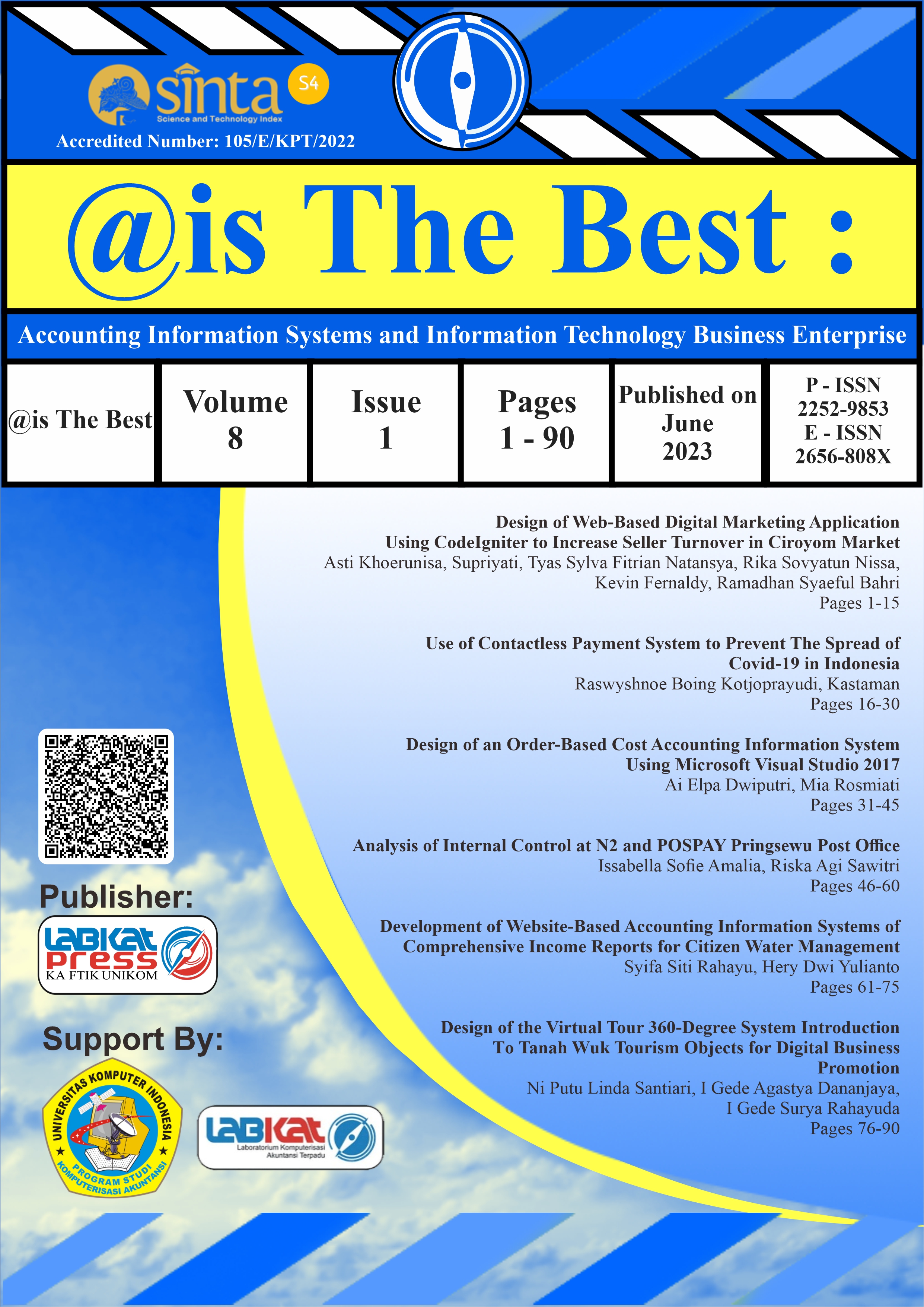Use of Contactless Payment System to Prevent The Spread of Covid-19 in Indonesia
Main Article Content
Abstract
World Health Organization has classified COVID-19 as a pandemic. Many hotels were forced to close because no guests came. Scientists agree that COVID-19 cannot be stopped, experts believe it can be delayed greatly using current "social distancing". This study aims to support the development of payment applications using the Contactless Payment (CP) method by presenting statistical data usage in people around the world. CP payments have become popular and are more accepted as a new payment method in both developed and developing countries. CP continues to grow and influences many factors such as greater spread, financial inclusion, and becoming more convenient, faster, and cheaper. CPs like this play an important role in shaping ecosystems, from regulators, financial institutions, toolmakers, retailers, or vendors, to consumers themselves. The results demonstrated that the technology developed was capable of speeding up and simplifying the hotel booking transaction process. The study's findings also show that the system that was constructed is helpful and that it can be used as part of the digital transformation of direct payments into online payments, as well as one of the options for decreasing the spread of the pandemic. The research conducted in this journal is using quantitative research. The use of CP in Indonesia after the pandemic increased in 2019 (0.3%) and 2020 (0.6%) from the previous year. The presentation method used is secondary data and literature study. This study will compare survey results from several kinds of literature.
Downloads
Article Details
Section

This Journal is licensed under a Creative Commons Attribution-ShareAlike 4.0 International License
How to Cite
References
M. G. Manoj, M. K. Satheesh Kumar, K. T. Valsaraj, C. Sivan, and S. K. Vijayan, “Potential link between compromised air quality and transmission of the novel coronavirus (SARS-CoV-2) in affected areas,” Environmental Research, vol. 190, p. 110001, 2020, doi: https://doi.org/10.1016/j.envres.2020.110001.
F. Richter, “Coronavirus: This chart shows why social distancing is so important,” World Economic Forum, 2020. [Online]. Available: https://www.weforum.org/agenda/2020/03/social-distancing-measures-coronavirus-covid19/. [Accessed: 09-Mar-2023].
S. Supriyati, S. Mulyani, H. Suharman, and T. Supriadi, “The Influence of Business Models, Information Technology on the Quality of Accounting Information Systems Digitizing MSMEs Post-COVID-19,” Jurnal Sistem Informasi, vol. 18, no. 2, pp. 36–49, 2022, doi: 10.21609/jsi.v18i2.1141.
Supriyati et al., Ekonomi Manajerial & Strategi Bisnis. Kab. Serang Banten: PT Sada Kurnia Pustaka, 2023.
S. Keelery, “Distribution of hotel payment methods across India in FY 2017, by star category,” Statista, 2022. [Online]. Available: https://www.statista.com/statistics/730168/share-of-hotel-payment-methods-by-star-category-india/. [Accessed: 09-Jan-2023].
N. Najla, S. Supriyati, and D. A. Dewi, “Design of Sales Accounting Information System Using EMKM Accounting Standard,” @is The Best : Accounting Information Systems and Information Technology Business Enterprise, vol. 7, no. 2, pp. 166–180, 2023, doi: 10.34010/aisthebest.v7i2.9125.
M. Rafa’al, “Mobile Payment Sebagai Sisitem Pembayaran Masa Depan,” OSF Preprints, 2018, doi: https://doi.org/10.31219/osf.io/z56hk.
W. Puriwat and S. Tripopsakul, “Explaining an adoption and continuance intention to use contactless payment technologies: During the covid-19 pandemic,” Emerging Science Journal, vol. 5, no. 1, pp. 85–95, 2021, doi: 10.28991/esj-2021-01260.
O. H. Chi, A. Saldamli, and D. Gursoy, “Impact of the COVID-19 pandemic on management-level hotel employees’ work behaviors: Moderating effects of working-from-home,” International Journal of Hospitality Management, vol. 98, p. 103020, 2021, doi: https://doi.org/10.1016/j.ijhm.2021.103020.
T. Trütsch, “The impact of contactless payment on cash usage at an early stage of diffusion,” Swiss Journal of Economics and Statistics, vol. 156, no. 1, p. 5, 2020, doi: 10.1186/s41937-020-00050-0.
S. Aulia, “Pola Perilaku Konsumen Digital Dalam Memanfaatkan Aplikasi Dompet Digital,” Jurnal Komunikasi, vol. 12, no. 2, pp. 311–324, Dec. 2020, doi: 10.24912/jk.v12i2.9829.
H. Karjaluoto, A. A. Shaikh, M. Leppäniemi, and R. Luomala, “Examining consumers’ usage intention of contactless payment systems,” International Journal of Bank Marketing, vol. 38, no. 2, pp. 332–351, Jan. 2020, doi: 10.1108/IJBM-04-2019-0155.
R. de Best, “Distribution of payment methods used at POS (points of sale) in the Netherlands from 2010 to 2020, based on transaction volume,” Statista, 2023. [Online]. Available: https://www.statista.com/statistics/1032423/volume-share-of-pos-payments-in-the-netherlands-by-method/. [Accessed: 09-Mar-2023].
L. Diayudha, “Industri Perhotelan Di Indonesia Pada Masa Pandemi Covid-19: Analisis Deskriptif,” Journal FAME: Journal Food and Beverage, Product and Services, Accommodation Industry, Entertainment Services, vol. 3, no. 1, Jun. 2020.
Supriyati and R. S. Bahri, “Model Design of Accounting Information Systems for Village Owned Enterprises ({BUMDes}),” {IOP} Conference Series: Materials Science and Engineering, vol. 879, p. 12093, 2020, doi: 10.1088/1757-899x/879/1/012093.

